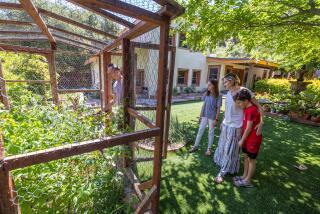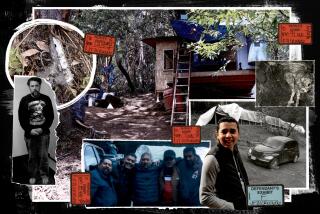Only bare dirt remained and a hole in the ground where the swimming pool had been.
“A lot has happened, please call,” the message said.
It was from Mary Surina, the Azalea Lady.
I hadn’t seen her since February of 1986. In my last picture of her, she was sitting on an electric warehouse truck, smoking a cigarette and looking out over the shaded acres of her azalea and camellia nursery.
“This is a happy place,” she told me that day.
I didn’t think Surina was likely to exaggerate. So, instead of phoning Monday, when I got the message, I drove out to the nursery on Parthenia Street, just west of the San Diego Freeway, a 2 1/2-acre private rural reserve amid a long-ago developed neighborhood.
A lot had happened, indeed.
The old, rusty sign that was the only visible advertisement for the nursery was gone, replaced by a larger, freshly painted billboard that said: “Eleven New Homes Due For Completion: Spring of ’88.”
The tall sycamores, figs and magnolia that once hid the nursery from the street had mostly been cut down, leaving a few naked trunks behind.
The rickety shade structures that extended what seemed like a quarter-mile back to the next street were also gone. So were all the azaleas and camellias that used to be squeezed side by side in pots to the back of the lot.
Surina’s house, a rambling country-French blend, was gone too. Only bare dirt remained and a hole in the ground where the swimming pool had been.
From a nearby pay phone I called the number on the message. Surina answered.
She said she was only a few blocks away, where Tupper Street dead-ends into the San Diego Freeway.
“I rented this place two days before I went to the hospital,” she said.
I drove right over to see her.
Surina’s new quarters were in a strange neighborhood of spacious, old, ranch-style houses, now mostly in neglect, with dusty yards and graffiti-tarnished walls and fences.
A hand-painted sign pointed out the nursery entrance, beside a bare plywood shack.
Francisco, Surina’s faithful assistant, stood outside the shack. He had been with the nursery 11 years and promised Surina’s husband, before his death, to stay as long as he was needed.
“You want to buy azaleas?” he asked.
When I said I wanted to see Mary, he led me back through temporary rows of azaleas, ancient mounds of debris and through the kitchen door of the house.
Surina was there, in a wheelchair. She was saying goodby to a woman named Myrna, who Surina said was her herbalist.
“The Monkees lived here,” she informed me right away.
I wheeled Surina into an expansive living room and she told me how she came to live in the one-time house of the famous pop music group.
After 29 years in the nursery on Parthenia, Surina had sold the property to a developer, planning on retirement. She meant to sell her stock off gradually and then buy a house in Camarillo.
The buyer gave her a year to vacate the nursery. But things got busy, and Surina hadn’t sold out half of her stock when the time came to move. As a temporary measure, she rented the three acres at the dead end of Tupper Street.
“So two days after I rented it, I fell and broke my hip,” she said.
She was in Northridge Hospital Medical Center three months, first to let the hip heal, then to have replacement surgery on the other hip and, finally, to beat a staph infection.
When moving day came, Francisco hired five other men, erected the shades and moved all the azaleas and camellias, Surina said.
“Can you imagine how I must have felt lying in the hospital with everybody moving my stuff?”
After getting out of the hospital, she drove by to see the property.
“It gives you a funny feeling,” she said.
Meanwhile, her immediate situation is getting worse. Her plants are still not sold; she hasn’t found the right house, and her five-month lease on the Monkees’ house expires Sept. 17. She got a one-month extension, but soon, the Monkees’ house will also be demolished for new development.
“I always seem to be just ahead of progress,” she said. “Our first house, that I designed and we built and thought we would live in the rest of our lives, the freeway came along.”
As we talked, Francisco came to Surina with a problem. A landscaper waiting outside wanted to buy 100 five-gallon azaleas but didn’t want to pay the day’s asking price, $5. Francisco said he would only pay $4.50.
Surina thought it over and said she wouldn’t go lower than $4.75. Later, Francisco led the customer in. He and Surina bumped heads. Neither budged. The landscaper left.
The business may be winding down, but Surina’s love of azaleas is not.
“I have a nice stash for myself,” she said. “Don’t worry.”
That may be part of the problem. She still hasn’t found a new house that is large enough.
“I’m going to have to part with some of them,” she said.
On my way out, I saw the landscaper picking out a few of the best 15-gallons. He said he would be back in a few days for more. He figured the price would be down to $4 by then.







